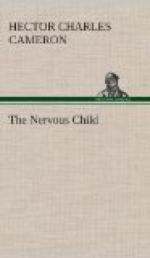Children differ very much in their attitude towards books. One child quite early in the second year will be happy poring over picture books, while another will seldom glance at the contents and finds pleasure only in turning over the pages, opening and shutting them, and carrying them from place to place. Such differences are natural enough and foreshadow perhaps the permanent characteristics that divide men and women, and produce in later life men of thought and men of action, women who are Marthas and women who are Marys. Nevertheless, we should bear in mind that there is danger in a training that is too one sided, and that books and toys have both their part to play in developing the powers of the child. All the activities of the child should be used in as varied a way as possible. The eye is but one doorway to knowledge and understanding, the ear is another, the hand a third.
From pictures an imaginative child will derive very strong impressions, and mothers should be careful in their choice. It is foolish to confuse the growth of aesthetic perceptions by presenting children with books which depict children as grotesquely ugly beings with goggle eyes and heads like rubber balls. Children love animals and endow them with all their own reasoning attributes, and in stories of the home life of rabbits, and bears, and squirrels they take a pure delight. Books of the “Struwwelpeter” type are less to be recommended. The faults which they are intended to eradicate become peculiarly attractive from much familiarity. A little boy of two and a half who resolutely refused all food for some days was in the end detected to be playing the part of that Augustus, once so chubby and fat, who reduced himself to a skeleton, saying, “Take the nasty soup away; I don’t want any soup to-day.” Tales of naughty children who meet with a distressing fate may either frighten the child unduly, or else produce in a child of inquiring mind the desire to brave his fate and put the matter to the test. Pictures should not be terrifying or horrible. Ogres devouring children are out of place as subjects for pictures and may cause night-terrors.
Children should be taught to be careful of books and toys. The indestructible book, generally falsely so called, is often responsible for the immediate dissolution of all others less protected which come to hand. The sympathy which little children have with the sufferings of all inanimate objects and their habit of endowing them with their own sensations may be made of use in teaching them care and gentleness. They are naturally prone to sympathise with the doll that has been crushed or the book that has been torn. They will learn very easily to be kind to a pet animal and to be solicitous for its feelings, and the lesson so learnt will be applied to inanimate objects as well.




